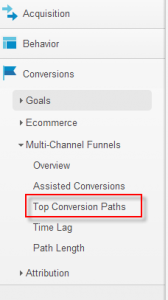Written by Erin Heffernan
Understanding the roles digital marketing channels play and how they interact with each other throughout the sales cycle are key components in gaining valuable insights to showing the value added to client-side or agency-led search engine marketing campaigns. As search engine marketers, we can sometimes become overly focused on the last click, and where the revenue, lead, or other KPIs directly came from. In doing so, we are essentially “putting on the blinders” and only seeing a small piece of the picture. Ignoring how paid, social, direct, referral, email and organic channels interact with each other can lead to poor decisions, which can ultimately hurt your bottom line.
To illustrate, let’s take this hypothetical example:
Your client is an ecommerce website who spends $5,000/month in paid advertising and generates $5,500 in paid revenue/month. If you continue to show numbers and ROI like this, your client may decide the $5,000 is better spent elsewhere. At this point, if other channels are producing higher ROIs, it would be the logical choice to put the ax on paid search and funnel funds to better performing mediums. Maybe that is ultimately the correct choice, but unless you dive into conversion paths and assisted conversions, you won’t know for sure.
When you start to think about how consumers purchase online, it becomes clear that you should be looking at conversion paths. Say you are looking for a pair of black boots. Your search path might look something like this:
- Search 1: Query: black boots, Click: Paid Ad (website 1), Action: bounce
- Search 2: Query: black boots for women, Click: Paid Ad (website 1), Action: search through pages of boots and bounce
- Search 3: Query: black riding boots for women, Click: Organic (website 2), Action: search through pages of boots and bounce
- Search 4: Query: (name of website 1) black riding boots for women, Click: Organic, Action: bookmark page
- Search 5: Come directly through bookmarked page, Action: Purchase
As you can see from this example, revenue is accredited to the last click (direct traffic), but both paid and organic search played a vital role in the sales cycle.
To learn the true impact your efforts are having and avoid tunnel vision, use Google Analytics Top Conversion Paths using the following steps:
- On the left hand navigation, select “Top Conversion Paths” under “Multi-Channel Funnels”

- Use advanced filters to include the channel you are analyzing, while excluding the channel as the last click. Remember you only want to see how a specific medium affected revenue when it was not the last click or direct source of revenue.

Now that your filter is applied you can see how PPC played a role in assisting conversions, and make more informed decision on the true value of any one medium.
What client wouldn’t be interested in know that paid advertising played a role in an additional 801 conversions for a total value of over $40,000? Not only did paid play a role in it, it was the 1st click for at least half of that $40,000. It is clear that if you take paid search out of the mix, your overall revenue would likely take a hit.
Pro Tip: Take it a step further by adding a secondary dimension to view keywords, landing pages, sources, ad content and more.
